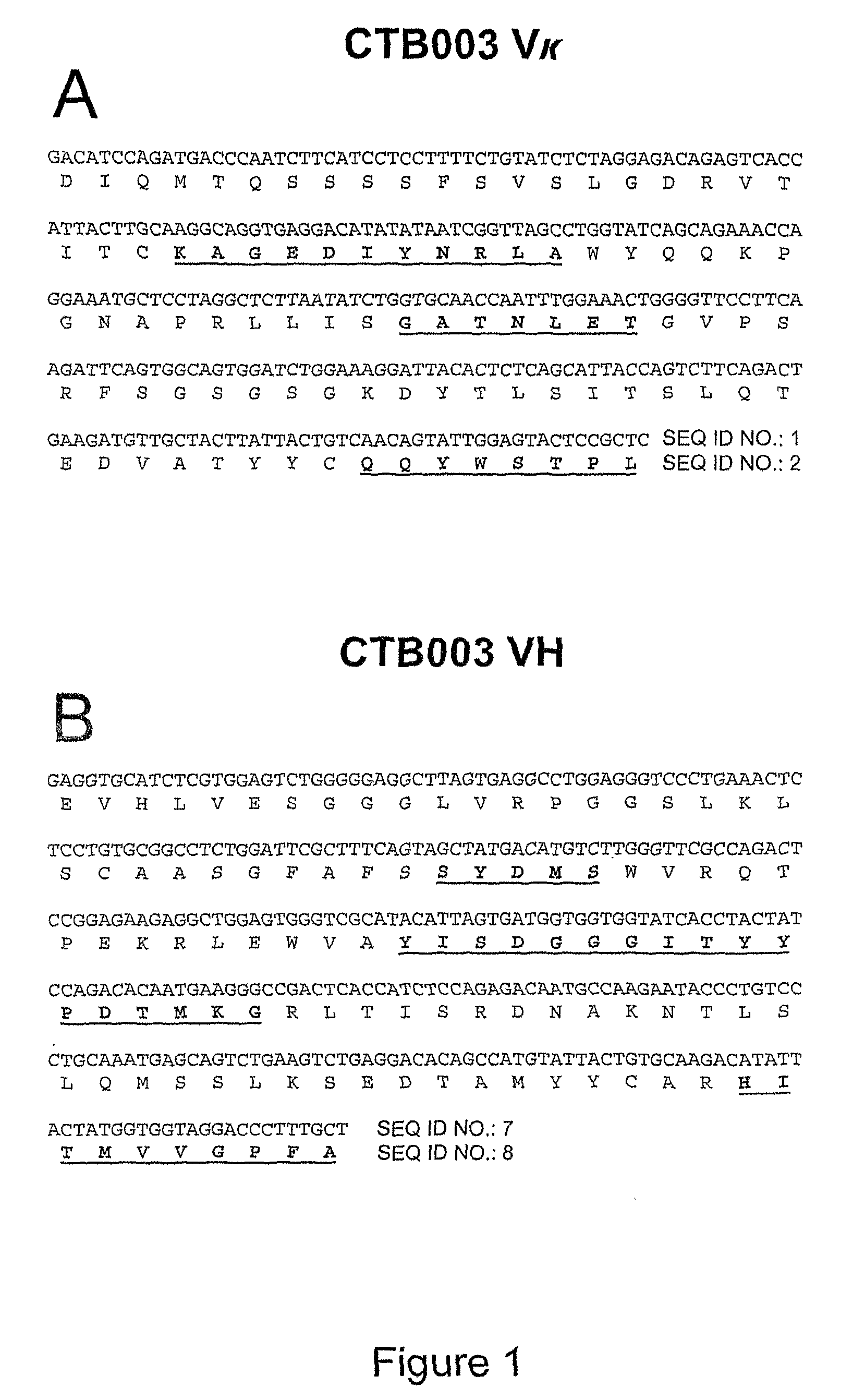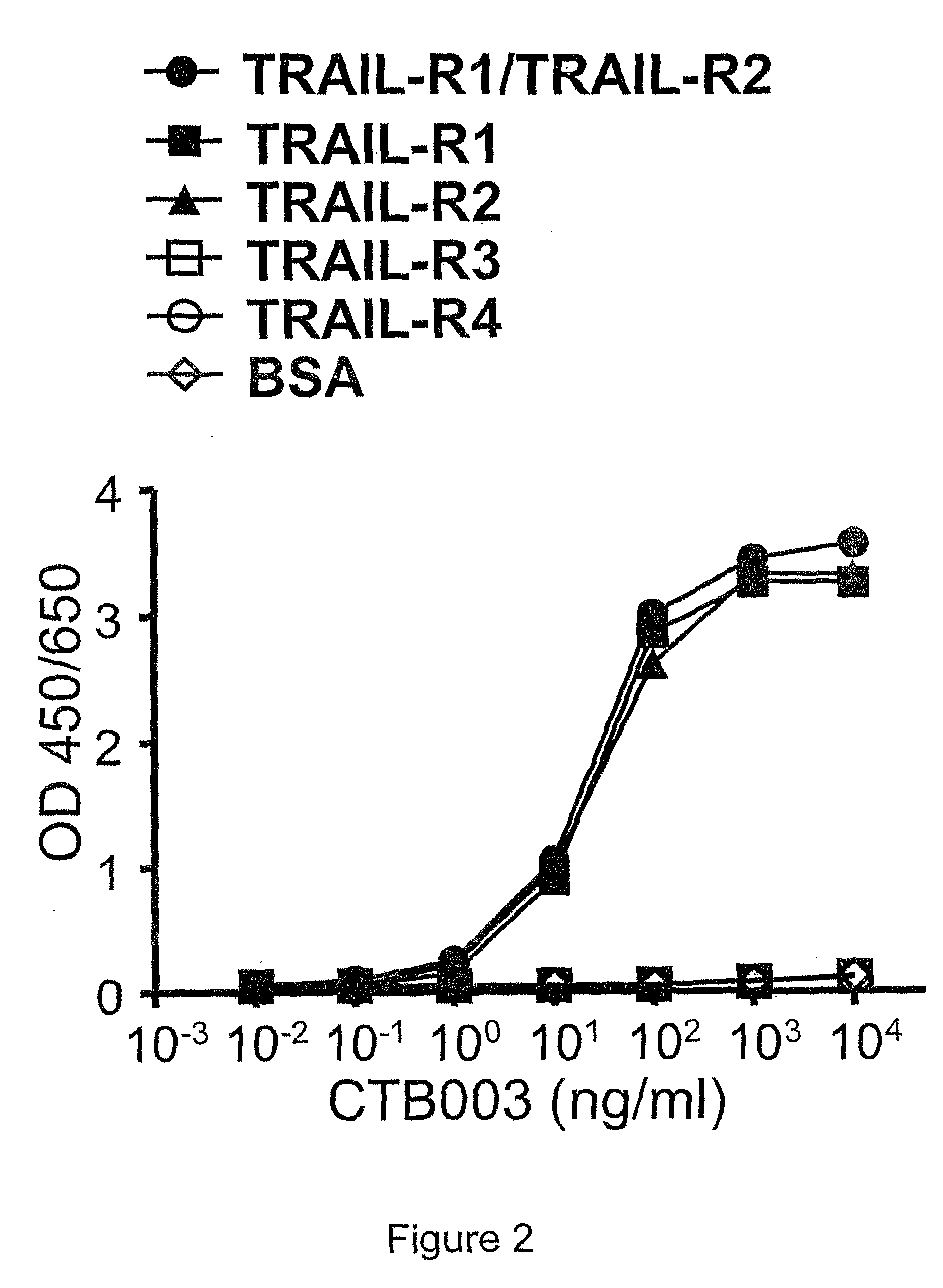Trail receptor-binding agents and uses of the same
a technology of receptors and binding agents, applied in the field of preparation of trail receptor binding agents, can solve the problems of increased tumor incidence with age, defective or insufficient expression, and no clinical application value of tnf- and fas ligand, and achieve the effect of enhancing the anti-cancer activity
- Summary
- Abstract
- Description
- Claims
- Application Information
AI Technical Summary
Benefits of technology
Problems solved by technology
Method used
Image
Examples
example 1
General Approach to the Preparation and Characterization of a Murine Trail Receptor-Binding Agent of the Invention
[0282]In particular, the TRAIL-R1 and / or TRAIL-R2 dual-specific monoclonal antibody CTB003 may be obtained by culturing a hybridoma which, in turn, may be obtained by immunizing a mouse with human TRAIL-R1 and / or TRAIL-R2 and subsequently fusing the spleen cells or lymph node cells from the mouse with mouse myeloma cells.
[0283]Preparation of a monoclonal antibody involves the following steps:
[0284]1. purification of a protein for use as an antigen;
[0285]2. preparation of antibody producing cells: after last immunizing an animal, serum sample was collected and analyzed for the titers of specific antibody production in order to determine whether antibody producing cells have been generated.
[0286]3. preparation of myeloma cells;
[0287]4. fusing the antibody producing cells and myeloma cells;
[0288]5. selecting a hybridoma producing a desired antibody;
[0289]6. preparing a sing...
example 2
Preparation of a Heterodimeric Form of TRAIL-R1 and TRAIL-R2 Antigen
[0327]1. Cloning of TRAIL-R1 and TRAIL-R2 cDNA
[0328]DNA encoding the human TRAIL-R1 and TRAIL-R2 protein was cloned by the following RT-PCR method using:
[0329]a) Template
[0330]The total RNA of HeLa cells was extracted by using TRIzol Reagent (GIBCO BRL). The template for the PCR reaction used cDNA that was obtained by using the First-Strand cDNA synthesis kit (Amersham Pharmacia Biotech) according to the instruction manual provided with the kit.
[0331]b) PCR Primers
[0332]The following oligonucleotide primers were synthesized for the PCR:
(DR5p1: SEQ ID NO.:49)5′-gacgatgcccgatctactttaaggg-3′;(DR5p2: SEQ ID NO.:50)5′-ccactgggtgatgttggatggg-3′;(DR4p1: SEQ ID NO.:51)5′-gacgatgcccgatctactttaaggg-3′;(DR4p2: SEQ ID NO.:52)5′-gacgatgcccgatctactttaaggg-3′;
c) PCR Reaction
[0333]Composition of the PCR reaction solution:
template cDNA, 5 μl of total 33 μl reaction
primer DR5p1, 10 pmol;
primer DR5p2, 10 pmol;
10×. concentrated PCR buf...
example 3
Generation of Monoclonal Antibodies Against Human TRAIL-R1 and TRAIL-R2
[0344]1. Immunization
[0345]Female, Balb / c mice (Jackson Laboratory, Bar Harbor, Me.) of 6-8 weeks of age, were immunized with the affinity-purified human TRAIL-R1 and TRAIL-R2-Fc fusion protein. For the initial foot-pad immunization, the fusion protein (50 μg) was emulsified in Freund's complete adjuvant (Difco, Detroit, Mich.). The mice were then boosted with four injections of 50 μg of fusion protein administered without adjuvant every other day. Three days after the last injection, lymphocytes from the local lymph nodes were collected.
[0346]2. Cell Fusion
[0347]Single cell suspension was prepared from lymph nodes, and mixed with NS1 myeloma cells at a ratio of 2:1. The resulting mix was washed three times with PRMI-1640. One ml, 37° C. prewarmed, of 50% (w / v) polyethylene glycol 1500 (Boehringer Manheim) was then slowly added to the tube, all the while stirring the pellet using the tip of a pipette. Subsequentl...
PUM
| Property | Measurement | Unit |
|---|---|---|
| Fraction | aaaaa | aaaaa |
| Temperature | aaaaa | aaaaa |
| Temperature | aaaaa | aaaaa |
Abstract
Description
Claims
Application Information
 Login to View More
Login to View More - R&D
- Intellectual Property
- Life Sciences
- Materials
- Tech Scout
- Unparalleled Data Quality
- Higher Quality Content
- 60% Fewer Hallucinations
Browse by: Latest US Patents, China's latest patents, Technical Efficacy Thesaurus, Application Domain, Technology Topic, Popular Technical Reports.
© 2025 PatSnap. All rights reserved.Legal|Privacy policy|Modern Slavery Act Transparency Statement|Sitemap|About US| Contact US: help@patsnap.com



